Geographical Types and Driving Mechanisms of Rural Population Aging–Weakening in the Yellow River Basin
Abstract
1. Introduction
2. Theoretical Analysis Framework
3. Study Area and Methodology
3.1. Study Area and Data
3.2. Indicator System for Assessing the Factors Influencing Rural Population Aging–Weakening
3.3. XGBoost Model and SHAP-Based Interpretability
4. Results
4.1. Overall Characteristics of Rural Population Aging–Weakening
4.2. Regional Differences in the Type of Population Aging–Weakening
4.3. Spatiotemporal Evolution and Regional Differentiation of Rural Population Aging–Weakening in the YRB
5. Discussion
5.1. Drivers of Rural Population Aging–Weakening in the YRB
5.2. Mechanism of Spatial Differentiation of Rural Population Aging–Weakening in Different Areas of the YRB
5.3. Shortcomings and Future Research
6. Conclusions
Author Contributions
Funding
Data Availability Statement
Conflicts of Interest
References
- Liu, Y.S.; Zhou, Y.; Li, Y.H. Rural regional system and rural revitalization strategy in China. Acta Geogr. Sin. 2019, 74, 2511–2528. [Google Scholar]
- Cao, Z.; Li, Y.R.; Chen, Y.F. Appro aches to rural transformation and sustainable development in the context of urban-rural integration. Acta Geogr. Sin. 2019, 74, 2560–2571. [Google Scholar]
- Li, Y.R.; Cao, L.Z.; Wang, P.Y.; Chang, G.J. Rural living environment improvement and rural revitalization. J. Nat. Resour. 2022, 37, 96–109. [Google Scholar] [CrossRef]
- Wang, G.X.; Gan, Y.H. Population Aging in China and Regional Economic Growth. Chin. J. Popul. Sci. 2017, 3, 30–42+126–127. [Google Scholar]
- Peng, X.Z.; Hu, Z. China’s Population Aging from the Perspective of Public Policy. Soc. Sci. China 2011, 2011, 121–138+222–223. [Google Scholar]
- Long, H.L. Land consolidation and rural spatial restructuring. Acta Geogr. Sin. 2013, 68, 1019–1028. [Google Scholar]
- Liao, L.W.; Gao, X.L. Progress and prospect of research on the impact of population aging on rural development. Prog. Geogr. 2018, 37, 617–626. [Google Scholar]
- Leadership Office of the Seventh National Population Census of the State Council. China’s Population Census Data by County-2020; Statistics Press: Beijing, China, 2022. [Google Scholar]
- Yang, R.; Liu, Y.S.; Guo, L.Y.; LI, Y.H. Spatial-temporal characteristics for rural hollowing and cultivated land use intensive degree: Taking the Circum-Bohai Sea region in China as an example. Prog. Geogr. 2013, 32, 181–190. [Google Scholar]
- Li, Y.H.; Wang, H. Spatial Distribution of Rural Population Flow at the Village Level in China: Evidence from Village Samples in the Third National Agricultural Census. Chin. Rural. Econ. 2017, 4, 124–144. [Google Scholar]
- Liu, S.; Xiao, W.; Ye, Y.; He, T.; Luo, H. Rural residential land expansion and its impacts on cultivated land in China between 1990 and 2020. Land Use Policy 2023, 132, 106816. [Google Scholar] [CrossRef]
- Wang, G.; Liu, Y. The Process of Rural Hollowing Out and Its Resource and Environmental Effects; Science Press: Beijing, China, 2017. [Google Scholar]
- Li, Y.H.; Hans, W.; Liu, Y.S. Why some rural areas decline while some others not: An overview of rural evolution in the world. J. Rural. Stud. 2019, 68, 135–143. [Google Scholar] [CrossRef]
- Liu, Y. Urban-Rural Transformation Geography; Springer Nature: Singapore, 2021. [Google Scholar]
- Liu, Y.W.; Xiao, C.J.; Ma, X.D.; Li, X. Impact pathways of rural population reduction on arable land transition. Prog. Geogr. 2024, 43, 1088–1101. [Google Scholar]
- Fu, Z.H.; Yang, Y.H.; Qiao, J.J.; Zhu, X.Y.; Jiang, X.J. Rural hollowing out in the Yellow River Basin andthe development path of rural revitalization. Prog. Geogr. 2024, 43, 1049–1059. [Google Scholar]
- Fu, Z.H.; Yang, Y.H.; Wang, L.J.; Zhu, X.Y.; Lv, H.; Qiao, J.J. Geographical Types and Driving Mechanisms of Rural Hollowing-Out in the Yellow River Basin. Agriculture 2024, 14, 365. [Google Scholar] [CrossRef]
- Nina, G.; David, L.B. Rural ageing in the United States: Trends and contexts. J. Rural. Stud. 2012, 28, 422–431. [Google Scholar]
- Guo, Y.Z.; Zhou, Y.; Han, Y. Population aging in rural China: Spatial-temporal pattern and countermeasures for rural revitalization. Geogr. Res. 2019, 38, 667–683. [Google Scholar]
- Zhao, D.X.; Han, Z.L.; Wang, L. The spatial pattern of aging population distribution and its generating mechanism in China. Acta Geogr. Sin. 2017, 72, 1762–1775. [Google Scholar]
- Liu, Z.; Rodríguez, S.E. Research on the Interaction Mechanism between Land System Reform and Rural Population Flow: Europe (Taking Spain as an Example) and China. Land 2024, 13, 1162. [Google Scholar] [CrossRef]
- Yang, J.H.; Wang, S.S.; Liu, Y.F. 70 Years of China: Analysis on the Trend of Population Aging. Chin. J. Popul. Sci. 2019, 4, 30–42+126. [Google Scholar]
- Zhou, R.; Zhuang, R.L.; Huang, C.X. Pattern evolution and formative mechanism of aging in China. Acta Geogr. Sin. 2019, 74, 2163–2177. [Google Scholar]
- Liao, L.W.; Long, H.L.; Gao, X.L.; Ma, E.P. Effects of land use transitions and rural aging on agricultural production in China’s farming area: A perspective from changing labor employing quantity in the planting industry. Land Use Policy 2019, 88, 104152. [Google Scholar] [CrossRef]
- An, C.B.; Jeon, S.H. Demographic change and economic growth: An inverted-U shape relationship. Econ. Lett. 2006, 92, 447–454. [Google Scholar] [CrossRef]
- Qiu, T.W.; Peng, C.Y. The Impact of Aging Agricultural Population on Farmland Allocation and Grain Production Decision: Evidence from the China Household Finance Survey. China Rural. Surv. 2023, 4, 129–150. [Google Scholar]
- Liu, J.Z.; Fang, Y.G.; Wang, G.; Liu, B.C.; Wang, R.R. The aging of farmers and its challenges for labor-intensive agriculture in China: A perspective on farmland transfer plans for farmers’ retirement. J. Rural. Stud. 2023, 100, 103013. [Google Scholar] [CrossRef]
- Burholt, V.; Dobbs, C. Research on rural ageing: Where have we got to and where are we going in Europe? J. Rural. Stud. 2012, 28, 432–446. [Google Scholar] [CrossRef]
- Chen, J.D.; Wang, Y.; Wen, J.; Fang, F.Q.; Song, M.L. The influences of aging population and economic growth on Chinese rural poverty. J. Rural. Stud. 2016, 47, 665–676. [Google Scholar] [CrossRef]
- Zou, B.L.; Ashok, K.M.; Luo, B.L. Aging population, farm succession, and farmland usage: Evidence from rural China. Land Use Policy 2018, 77, 437–445. [Google Scholar] [CrossRef]
- Davis, S.; Bartlett, H. Review Article: Healthy ageing in rural Australia: Issues and challenges. Australas. J. Ageing 2008, 27, 56–60. [Google Scholar] [CrossRef]
- Su, B.L.; Li, Y.H.; Zheng, X.D. Who are to support the aged in rural China? The study of people’s willingness to purchase socialized care service and its influencing factors. J. Rural. Stud. 2022, 93, 496–503. [Google Scholar]
- Han, Y.H.; Liu, Y. Low Fertility and Aging, Industrial Intelligence and Macroeconomic Fluctuations: An Analysis of DSGE Model Based on Endogenous Economic Growth Theory. Manag. World 2024, 40, 20–37+60+38. [Google Scholar]
- Guo, Y.Z.; Wang, J.Y. Practices for rural population aging in China: Land-based pension. Habitat Int. 2024, 151, 103136. [Google Scholar] [CrossRef]
- Massey, D. Space, Place and Gender; University of Minnesota Press: Minneapolis, MN, USA, 1994. [Google Scholar]
- Little, J. Gender and Rural Geography; Routledge: London, UK, 2002. [Google Scholar]
- Gillian, R. Feminism and Geography: The Limits of Geographical Knowledge; University of Minnesota: Minneapolis, MN, USA, 1993. [Google Scholar]
- Catherine, N. Reclaiming Vision: Looking at landscape and the body. Gend. Place Cult. 1996, 3, 149–170. [Google Scholar]
- Goedele, V.B.; Miet, M. Female Employment Reduces Fertility in Rural Senegal. PLoS ONE 2015, 10, e0122086. [Google Scholar]
- Katharina, K.; Miet, M.; Meike, W. Can employment empower women? Female workers in the pineapple sector in Ghana. J. Rural. Studies 2020, 80, 76–90. [Google Scholar]
- Zhang, L.X.; Alan, D.B.; Scott, R. China’s rural labor market development and its gender implications. China Econ. Rev. 2004, 15, 230–247. [Google Scholar] [CrossRef]
- Šikić-Mićanović, L. Women’s Contribution to Rural Development in Croatia: Roles, Participation and Obstacles. East. Eur. Countrys. 2009, 15, 75–90. [Google Scholar] [CrossRef]
- Phimister, E.; Vera-Toscano, E.; Weersink, A. Female participation and labor market attachment in rural Canada. Am. J. Agric. Econ. 2002, 84, 210–221. [Google Scholar] [CrossRef]
- Shui, Y.; Xu, D.; Liu, Y.; Liu, S. Work-family balance and the subjective well-being of rural women in Sichuan, China. BMC Women’s Health 2020, 20, 1. [Google Scholar] [CrossRef]
- Zhang, J.H. An Analysis of Obstacles for Female Migrant Workers’ Employment—From the Perspective of Protection of Rural Women’s Equal Employment Rights. J. China Women’s Univ. 2017, 29, 13–18. [Google Scholar]
- Li, N.; He, M. Feminization of poverty: An analysis of multidimensional poverty among rural women in China. Humanit. Soc. Sci. Commun. 2024, 11, 1–19. [Google Scholar] [CrossRef]
- Maletta, H. Gender and Employment in Rural Afghanistan, 2003—5. J. Asian Afr. Stud. 2008, 43, 173–196. [Google Scholar] [CrossRef]
- Koolwal, G.B. Improving the measurement of rural women’s employment: Global momentum and survey priorities. World Dev. 2021, 147, 105627. [Google Scholar] [CrossRef]
- Pratley, P. Associations between quantitative measures of women’s empowerment and access to care and health status for mothers and their children: A systematic review of evidence from the developing world. Soc. Sci. Med. 2016, 169, 119–131. [Google Scholar] [CrossRef]
- Akhter, H.M.; Alauddin, M. Coming out of their homesteads? Employment for rural women in shrimp aquaculture in coastal Bangladesh. Int. J. Soc. Econ. 1998, 25, 314–337. [Google Scholar] [CrossRef]
- Lawrence, M.; Homer-Dixon, T.; Janzwood, S.; Rockstom, J.; Renn, O.; Donges, J.F. Global polycrisis: The causal mechanisms of crisis entanglement. Glob. Sustain. 2024, 7, e6. [Google Scholar] [CrossRef]
- Matlovič, R.; Matlovičová, K. Polycrisis in the Anthropocene as Key ResearchAgenda for Geography: Ontological Delineation and the Shift to a Postdisciplinary Approach. Folia Geogr. 2024, 66, 5–33. [Google Scholar]
- Wu, L. Study on the Spatial and Temporal Characteristics of Population Ageing and Response Strategies in the Yangtze River Delta Region; Tianjin Academy of Social Sciences Press: Tianjin, China, 2023. [Google Scholar]
- Harry, M.; Jennifer, S. Aging; Chen, Y.; Li, X., Translators; Jiangsu People’s Publishing House: Nanjing, China, 2018. [Google Scholar]
- Li, X.J.; Yang, H.M. The Change of Rural Settlements and Their Future Development Patterns. Econ. Geogr. 2017, 37, 1–8. [Google Scholar]
- Zhang, W.W. Happiness of Family and Loneliness of Homesickness: A Study on the Urban Integration of Chinese Elderly with Migration. Popul. Dev. 2023, 29, 91–104. [Google Scholar]
- Ge, J.X. The Yellow River and Chinese Civilization; The Commercial Press: Beijing, China, 2020; pp. 188–196. [Google Scholar]
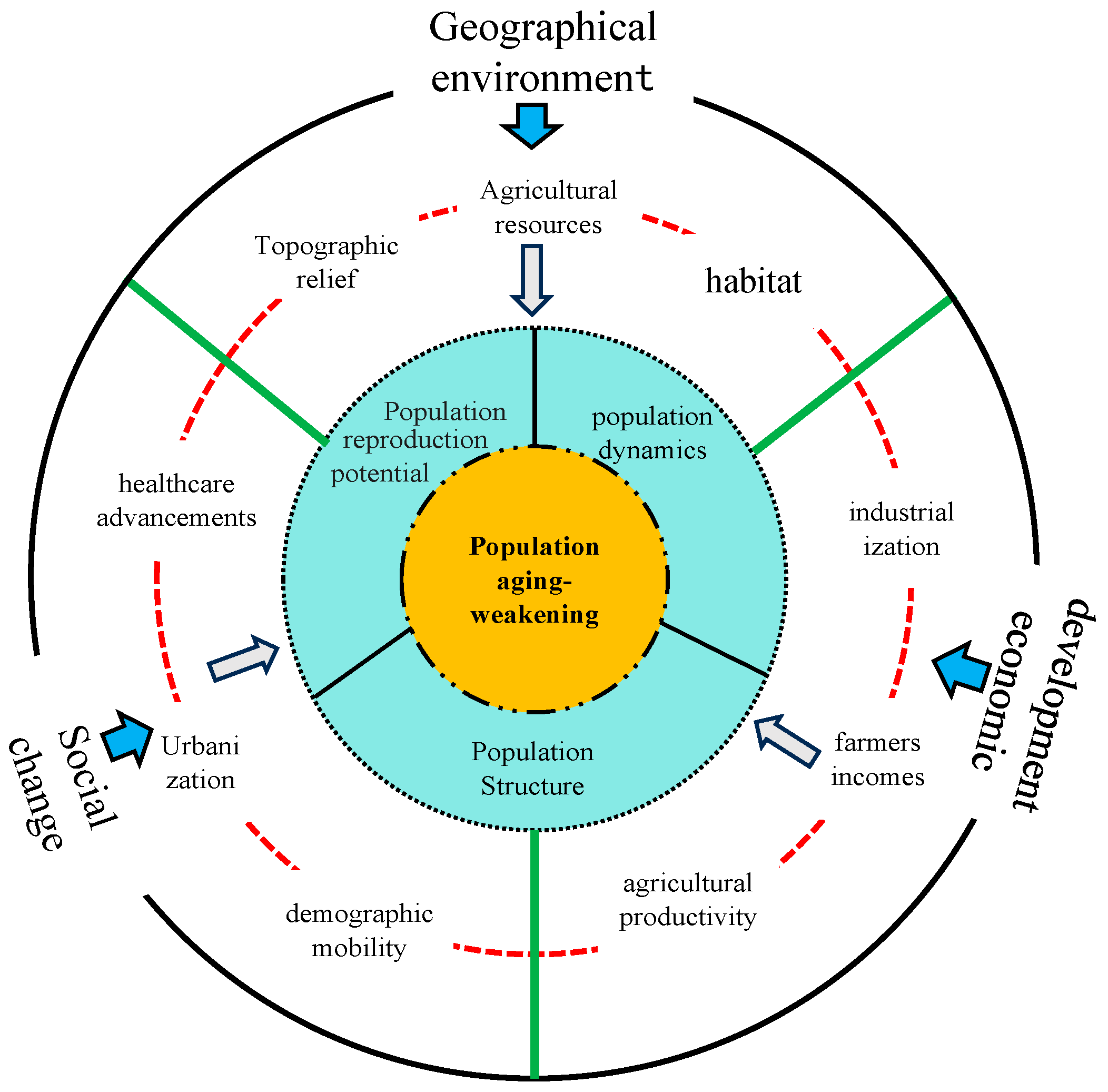
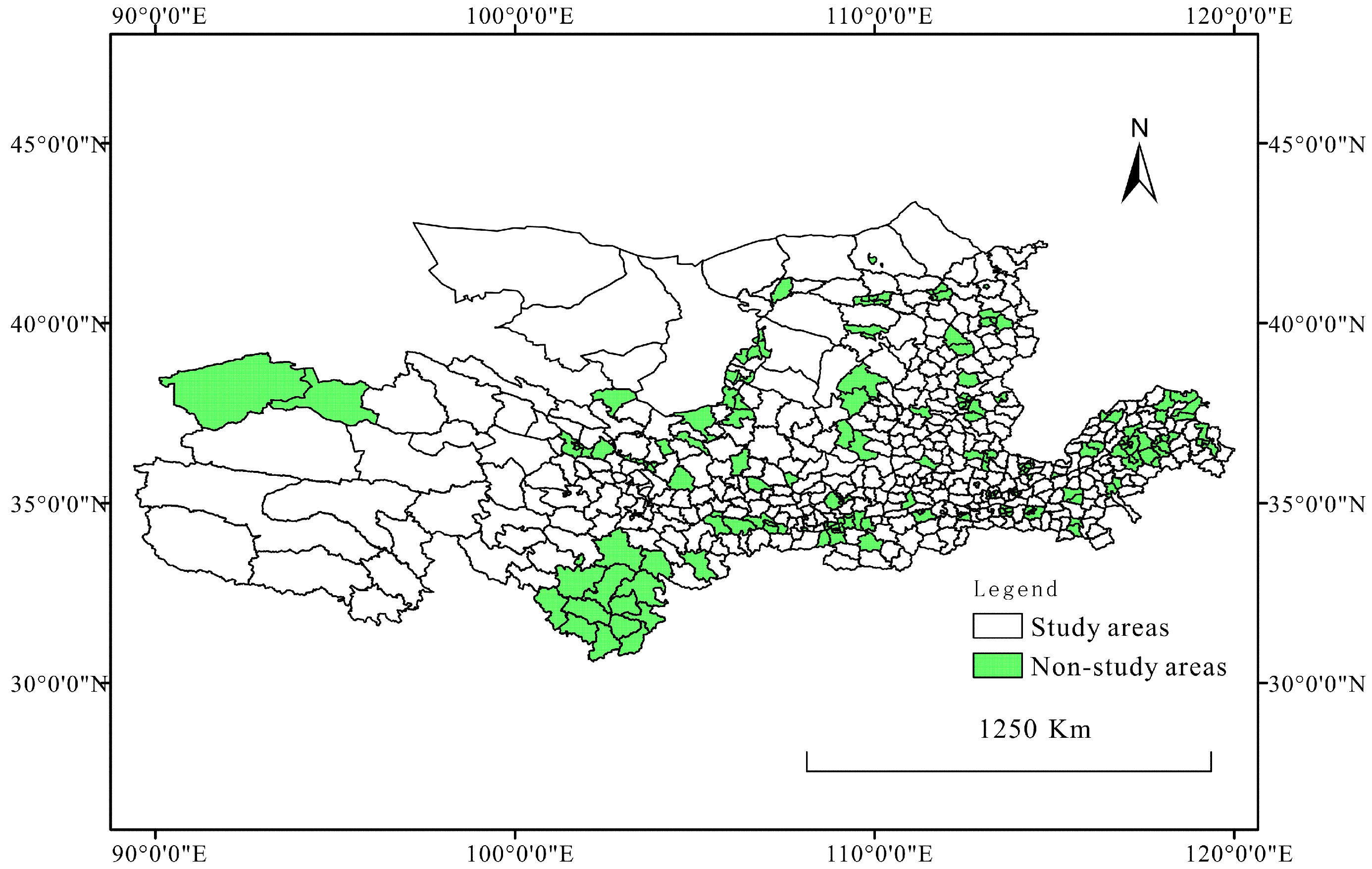
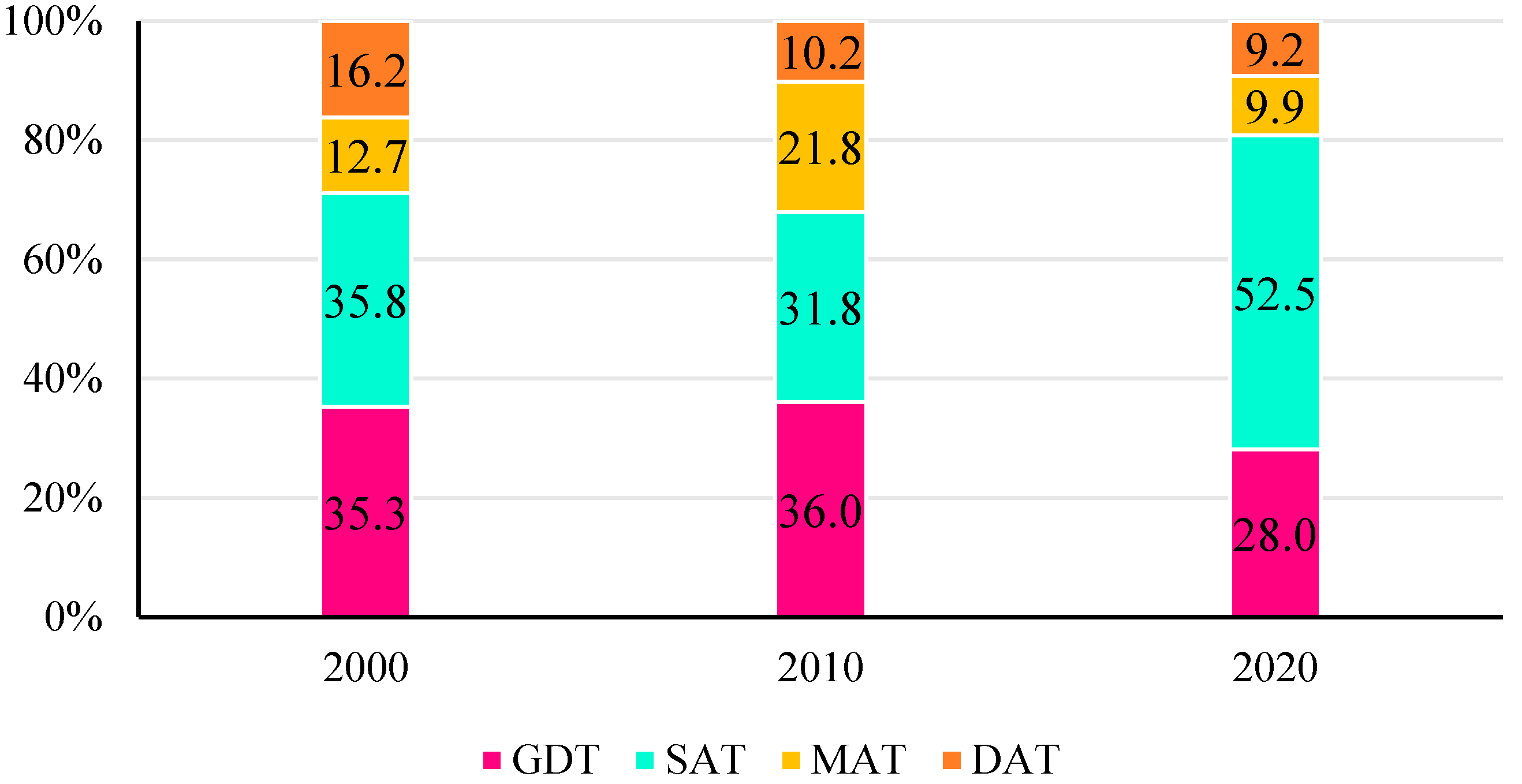

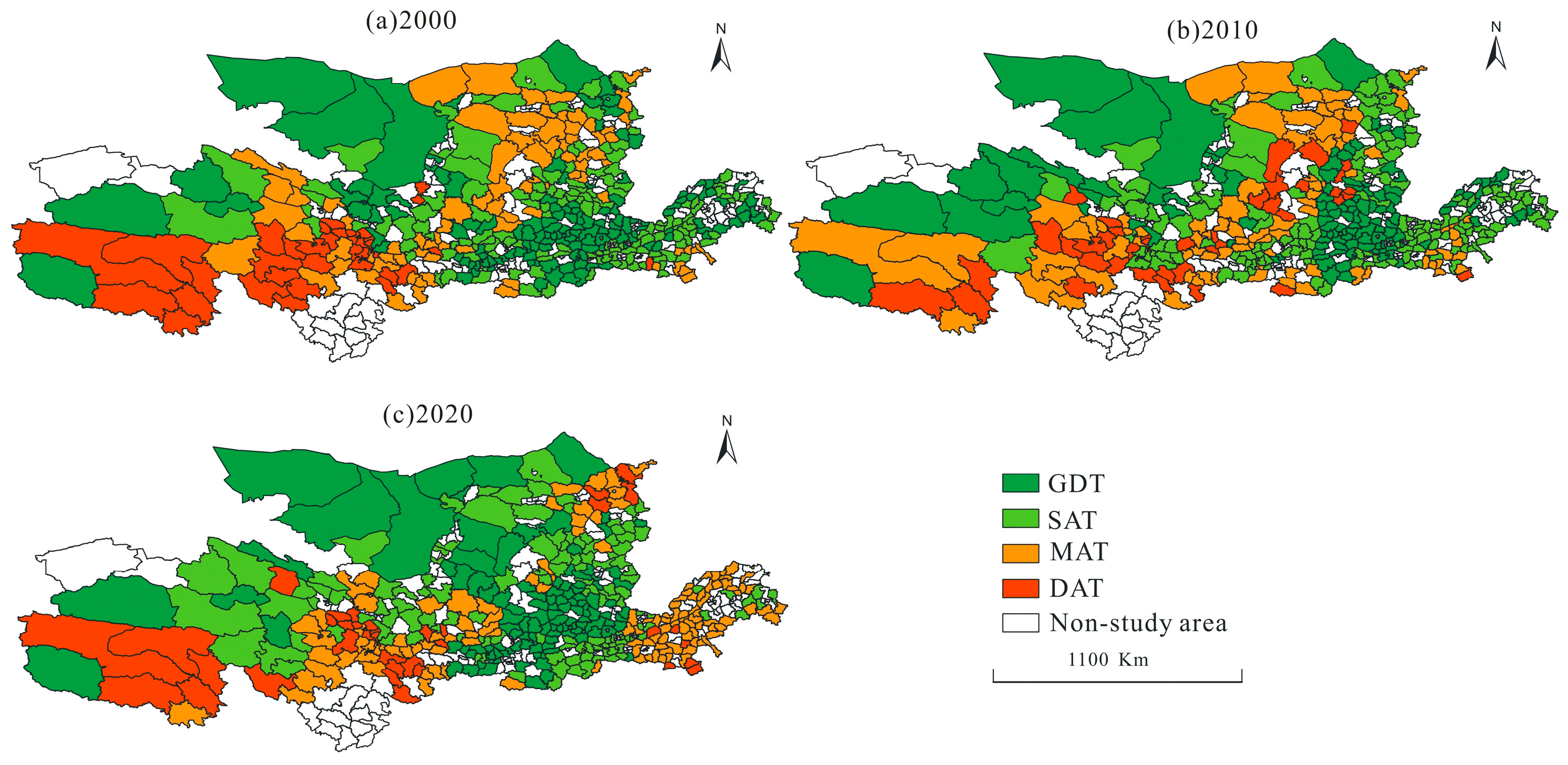
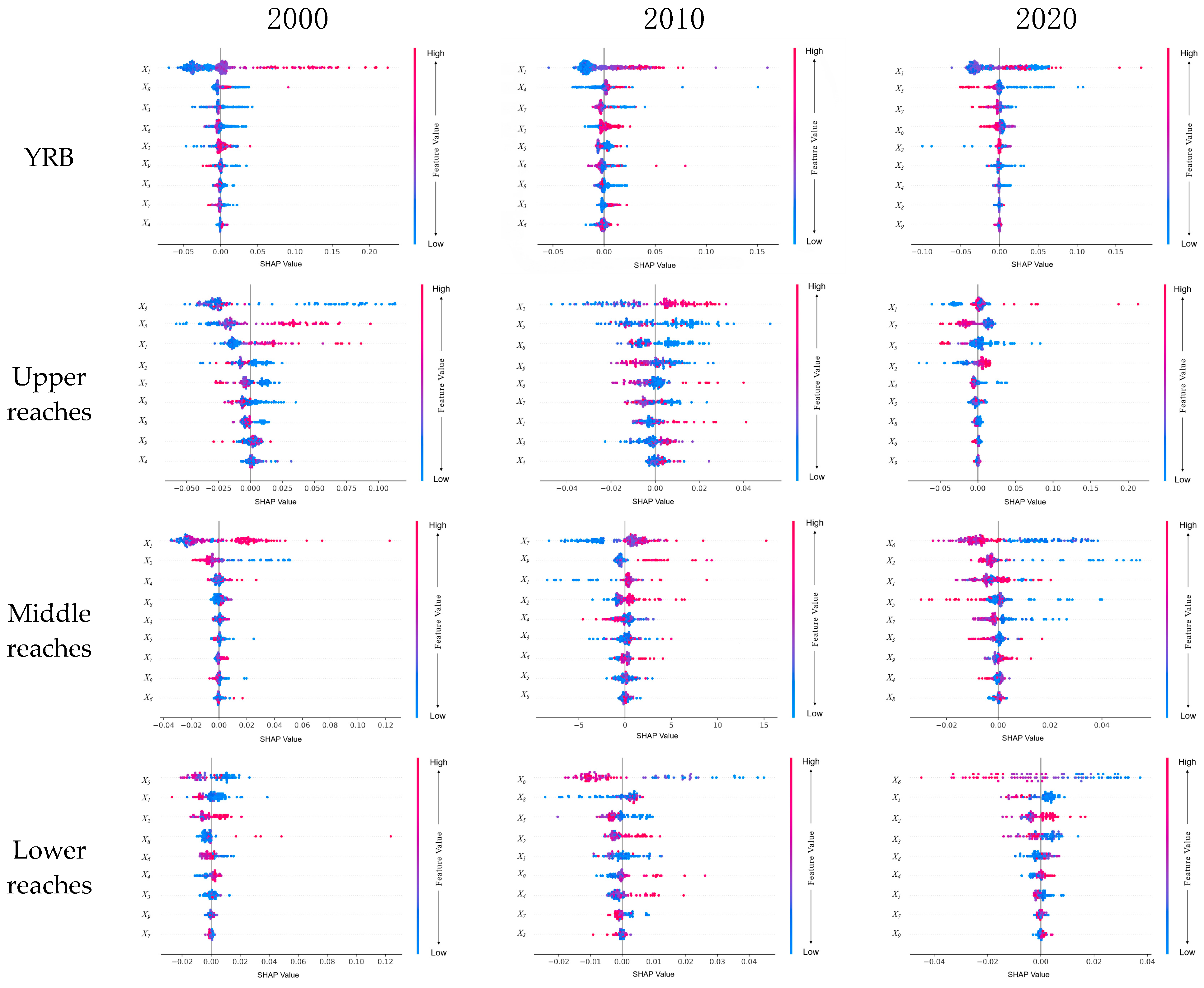
| Variable | Subsystems | Indicator | Meaning of Indicator |
|---|---|---|---|
| Population aging–weakening | Aging | Percentage of population aged 65 and above (%) | |
| Population structure | Number of children | Percentage of children aged 0–14 (%) | |
| Percentage of women | Female population/total population (%) | ||
| Population dynamics | Scale of illiteracy | Percentage of illiterates aged 15 and over (%) | |
| Workforce Scale | Percentage of resident working-age population (%) | ||
| Quality of population (in terms of educational attainment) | Proportion of population with a specialist degree or higher (%) | ||
| Population reproduction potential | Fertility | Fertility rate (%) | |
| Women of childbearing age | Percentage of women aged 15–49 (%) | ||
| Dependency ratio | 65 and over/15–64 (%) | ||
| Influencing factors | Geographical environment | Topographic relief (X1) | Average elevation (m) |
| Habitat (X2) | Vegetation cover | ||
| Agricultural resources (X3) | Per capita cultivated land area (mu/person) | ||
| Economic development | Agricultural productivity (X4) | Per capita value added in the primary industry (CNY 10,000 per capita) | |
| Industrialization (X5) | Per capita industrial value added (CNY 10,000 per capita) | ||
| Farmer income (X6) | Per capita disposable income of rural residents (CNY 10,000 per capita) | ||
| Social change | Urbanization (X7) | Proportion of urban population at the county level (%) | |
| Demographic mobility (X8) | Loss of permanent rural population (person) | ||
| Healthcare advancements (X9) | Hospital Beds per 10,000 people |
Disclaimer/Publisher’s Note: The statements, opinions and data contained in all publications are solely those of the individual author(s) and contributor(s) and not of MDPI and/or the editor(s). MDPI and/or the editor(s) disclaim responsibility for any injury to people or property resulting from any ideas, methods, instructions or products referred to in the content. |
© 2025 by the authors. Licensee MDPI, Basel, Switzerland. This article is an open access article distributed under the terms and conditions of the Creative Commons Attribution (CC BY) license (https://creativecommons.org/licenses/by/4.0/).
Share and Cite
Fu, Z.; Yang, Y.; Hu, S. Geographical Types and Driving Mechanisms of Rural Population Aging–Weakening in the Yellow River Basin. Agriculture 2025, 15, 1093. https://doi.org/10.3390/agriculture15101093
Fu Z, Yang Y, Hu S. Geographical Types and Driving Mechanisms of Rural Population Aging–Weakening in the Yellow River Basin. Agriculture. 2025; 15(10):1093. https://doi.org/10.3390/agriculture15101093
Chicago/Turabian StyleFu, Zhanhui, Yahan Yang, and Shuju Hu. 2025. "Geographical Types and Driving Mechanisms of Rural Population Aging–Weakening in the Yellow River Basin" Agriculture 15, no. 10: 1093. https://doi.org/10.3390/agriculture15101093
APA StyleFu, Z., Yang, Y., & Hu, S. (2025). Geographical Types and Driving Mechanisms of Rural Population Aging–Weakening in the Yellow River Basin. Agriculture, 15(10), 1093. https://doi.org/10.3390/agriculture15101093










